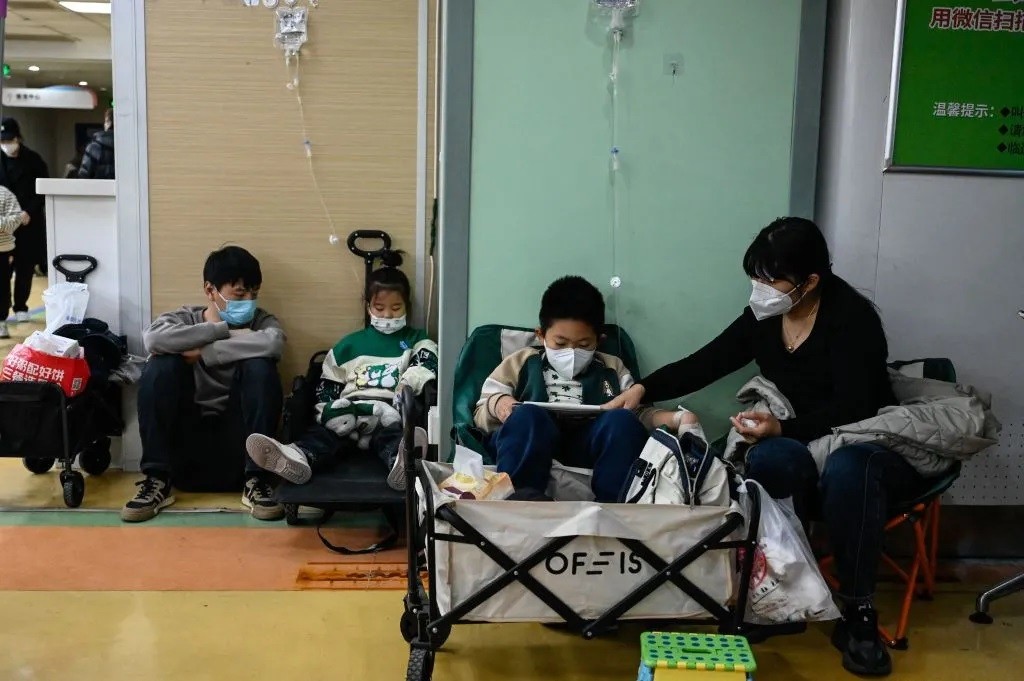23/11/2023
23/11/2023
BEIJING, Nov 23, (Agencies): Nearly four years after the initial reports of an influenza-like illness in Wuhan that ultimately led to the global Covid-19 pandemic, China is grappling with a resurgence of influenza-like illness, primarily affecting children. The surge in sick children has placed immense strain on Chinese hospitals, prompting concerns at the World Health Organization (WHO).

The WHO, referencing a press conference held by China's National Health Commission on November 12, revealed that the world's second-largest economy is witnessing a notable increase in respiratory diseases. ProMed, a publicly available surveillance system monitoring infectious disease outbreaks, issued an alert about "undiagnosed pneumonia" in children.
Chinese authorities attribute the rise in cases to the relaxation of Covid-19 restrictions and the circulation of known pathogens, including influenza, Mycoplasma pneumoniae (a common bacterial infection affecting younger children), respiratory syncytial virus, and the virus causing Covid.
Highlighting the strain on the healthcare system, Chinese authorities stress the need for enhanced disease surveillance in healthcare facilities and communities. They also underscore the importance of expanding the health system's capacity, which is currently overwhelmed due to the increasing number of infected children.
Recalling the infamous tweet by the WHO on January 14, 2022, which downplayed concerns over the Covid spread and absolved Chinese authorities, the organization now approaches a similar viral outbreak with increased caution. The tweet stated that preliminary investigations by Chinese authorities found no clear evidence of human-to-human transmission of the novel coronavirus.
As of Wednesday (Nov 22), the WHO reported clusters of undiagnosed pneumonia in children in northern China, raising uncertainty about their connection to the overall increase in respiratory infections reported by Chinese authorities. The health agency has formally requested additional epidemiologic and clinical information, along with laboratory results for these reported outbreaks among children, utilizing the International Health Regulations mechanism.
In mid-October, northern China witnessed a notable increase in "influenza-like illness," prompting the World Health Organization (WHO) to formally request detailed information from China regarding the surge in respiratory illnesses and clusters of pneumonia in children, as announced by the UN health body on Wednesday.
Last week, China's National Health Commission attributed the rise in respiratory illnesses to the relaxation of COVID-19 restrictions and the circulation of known pathogens, including influenza and common bacterial infections affecting children, such as mycoplasma pneumonia. Beijing, situated in the northern part of the country, is currently in the midst of a cold snap, with temperatures anticipated to drop well below zero by Friday, according to state media.
The city has entered a "high incidence season of respiratory infectious diseases," noted Wang Quanyi, deputy director and chief epidemiological expert at the Beijing Center for Disease Control and Prevention, emphasizing a trend of multiple pathogens coexisting.
Reports from journalists at Beijing's Capital Institute of Pediatrics Children's Hospital on Thursday depicted crowds of parents and children clad in winter attire. A parent named Zhang expressed concern about her coughing nine-year-old son, diagnosed with pneumonia, stating that many children had recently contracted respiratory illnesses.
Li Meiling, aged 42, brought her eight-year-old daughter suffering from mycoplasma pneumonia, a pathogen causing sore throats, fatigue, and fever. Despite the surge in cases, she expressed minimal concern, attributing it to the winter season.
On November 21, media and the ProMED disease surveillance system reported clusters of undiagnosed pneumonia in children in northern China. The WHO seeks clarification on whether ProMED's report is linked to the authorities' press conference. The organization has officially requested additional information on recent trends in known pathogens, including influenza, SARS-CoV-2 (the virus causing COVID-19), RSV affecting infants, and mycoplasma pneumoniae, along with details on the healthcare system's level of overcrowding.
In the interim, the WHO encourages preventive measures, including vaccination, maintaining distance from sick individuals, and mask-wearing. The organization provided no insight into China's response to the information request, and China's foreign ministry remained unresponsive to AFP's request for comment on Thursday.
Throughout the COVID-19 pandemic, the WHO has consistently criticized Chinese authorities for perceived transparency and cooperation shortcomings. The ongoing debate over the origins of COVID-19 remains contentious, with scientists divided between theories of a laboratory escape and transmission from an intermediate animal at a local market. WHO chief Tedros Adhanom Ghebreyesus emphasizes the importance of unraveling this mystery to prevent future pandemics.


